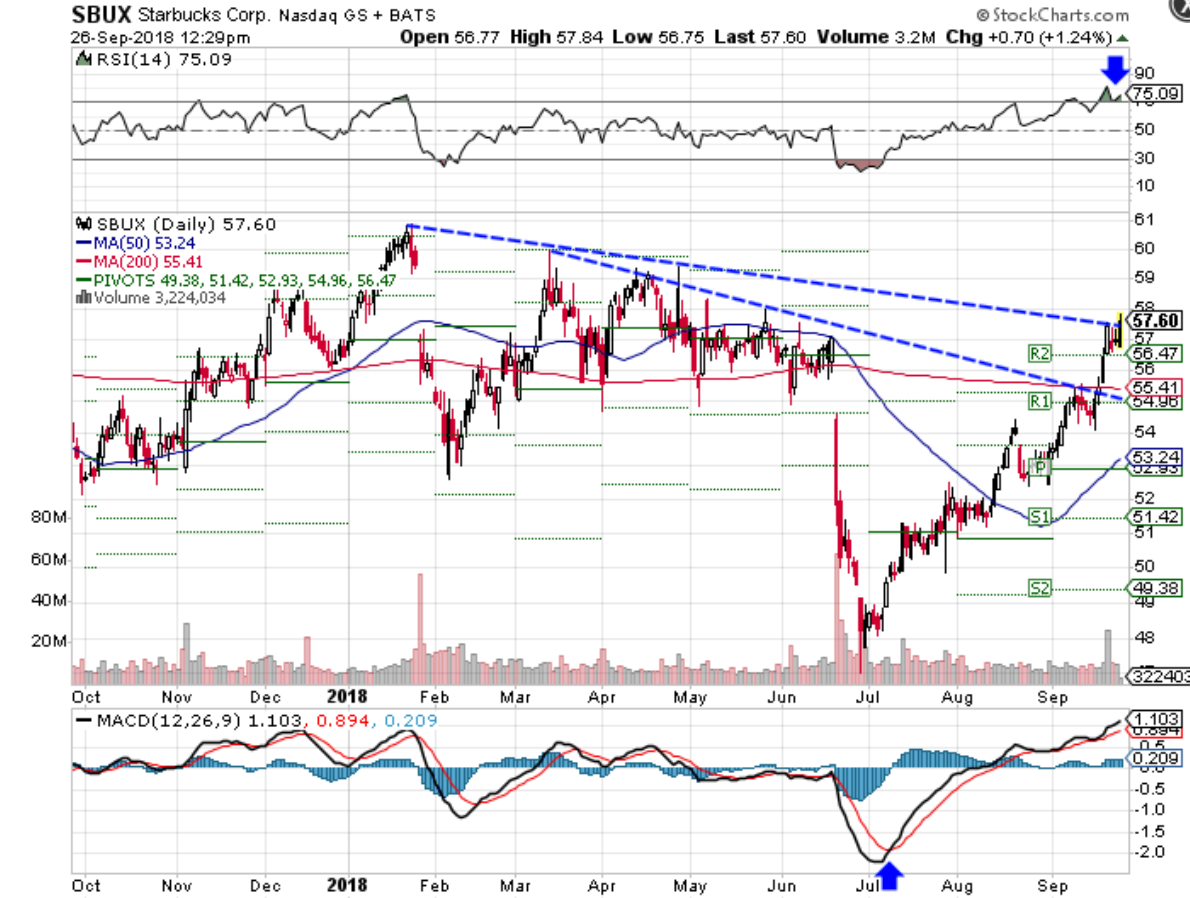Starbucks’ Business Strategy: Sbux Stock

Starbucks’ business strategy revolves around creating a unique customer experience, offering high-quality coffee and other beverages, and fostering a strong brand identity. This strategy has propelled Starbucks to become a global coffeehouse giant with a loyal customer base and a significant market share.
Starbucks’ Core Business Strategies
Starbucks’ core business strategies are built on the pillars of product innovation, customer experience, and brand building.
- Product Innovation: Starbucks constantly introduces new beverages, food items, and merchandise to keep its offerings fresh and appealing to customers. They are known for their seasonal drinks, collaborations with other brands, and personalized options.
- Customer Experience: Starbucks focuses on creating a welcoming and comfortable environment for its customers. They provide personalized service, a variety of seating options, and free Wi-Fi. They also leverage technology to enhance the customer experience, such as mobile ordering and payment.
- Brand Building: Starbucks has cultivated a strong brand identity that is associated with premium quality, innovation, and community. They are known for their ethical sourcing practices, environmental sustainability efforts, and social responsibility initiatives.
Starbucks’ Expansion Plans and Market Share
Starbucks’ expansion plans are focused on both geographic expansion and market penetration. They are expanding their presence in emerging markets, particularly in Asia and Africa, where there is significant growth potential. They are also focusing on increasing their market share in existing markets by opening new stores and expanding their product offerings.
- Geographic Expansion: Starbucks is expanding its presence in emerging markets, particularly in Asia and Africa, where there is significant growth potential. They are opening new stores in these regions, adapting their menu to local tastes, and building partnerships with local businesses.
- Market Penetration: Starbucks is also focusing on increasing its market share in existing markets by opening new stores, expanding their product offerings, and developing innovative marketing strategies.
Starbucks’ Digital Initiatives and Customer Loyalty Programs
Starbucks has invested heavily in digital initiatives to enhance the customer experience and build loyalty. Their mobile ordering and payment app, Starbucks Rewards program, and personalized offers are all designed to engage customers and drive repeat business.
- Mobile Ordering and Payment: Starbucks’ mobile app allows customers to order and pay for their beverages and food ahead of time, which saves them time and reduces wait times. This app has been a major success, with millions of customers using it daily.
- Starbucks Rewards Program: Starbucks Rewards is a loyalty program that rewards customers for their purchases with points that can be redeemed for free drinks, food, and merchandise. The program also provides personalized offers and exclusive content to members.
Starbucks’ Sustainability Efforts and Social Responsibility Initiatives
Starbucks is committed to sustainable practices and social responsibility. They are focused on sourcing coffee ethically, reducing their environmental footprint, and supporting communities around the world.
- Ethical Sourcing: Starbucks is committed to sourcing its coffee beans ethically and sustainably. They work with farmers to ensure fair wages, safe working conditions, and environmental protection.
- Environmental Sustainability: Starbucks is working to reduce its environmental footprint by using renewable energy, reducing waste, and conserving water. They are also investing in green building practices and sustainable packaging.
- Social Responsibility: Starbucks is committed to supporting communities around the world through its Community Grants Program, which provides funding to organizations that support education, youth development, and economic opportunity.
Challenges and Opportunities Facing Starbucks’ Business
Starbucks faces a number of challenges, including intense competition, rising costs, and changing consumer preferences. However, they also have a number of opportunities for growth, such as expanding into new markets, developing innovative products, and leveraging technology to enhance the customer experience.
- Challenges:
- Intense Competition: Starbucks faces intense competition from other coffeehouses, as well as from convenience stores and grocery stores that are offering increasingly sophisticated coffee options.
- Rising Costs: Starbucks is facing rising costs for ingredients, labor, and rent, which are putting pressure on its margins.
- Changing Consumer Preferences: Consumer preferences are constantly evolving, and Starbucks must adapt its offerings to meet the demands of its customers.
- Opportunities:
- Expanding into New Markets: Starbucks has significant opportunities for growth in emerging markets, particularly in Asia and Africa.
- Developing Innovative Products: Starbucks can continue to innovate its product offerings by introducing new beverages, food items, and merchandise.
- Leveraging Technology: Starbucks can leverage technology to enhance the customer experience, such as by developing new mobile apps, offering personalized recommendations, and providing seamless ordering and payment options.
Starbucks’ Stock Valuation

Starbucks, a global coffeehouse giant, has a significant presence in the stock market. Understanding its valuation is crucial for investors looking to capitalize on its growth potential or diversify their portfolios.
Current Valuation
Starbucks’ current valuation is determined by various factors, including its financial performance, market perception, and investor sentiment. The company’s market capitalization, a measure of its total value, reflects the current stock price multiplied by the number of outstanding shares.
As of October 26, 2023, Starbucks’ market capitalization was approximately $124 billion.
This valuation reflects investor confidence in the company’s ability to generate sustainable profits and grow its business.
Comparison to Historical Performance
Starbucks’ stock price has fluctuated significantly over time, influenced by economic conditions, industry trends, and company-specific events. However, the company has a history of long-term growth, reflecting its strong brand recognition, global expansion, and innovative product offerings.
In the past five years, Starbucks’ stock price has increased by approximately 100%, outperforming the broader market.
This historical performance provides insights into the company’s potential for future growth and investor confidence in its long-term prospects.
Key Factors Influencing Stock Price
Several factors can significantly influence Starbucks’ stock price:
- Financial Performance: Starbucks’ stock price is directly linked to its financial performance, including revenue growth, profitability, and cash flow. Strong earnings reports and positive financial forecasts typically drive stock prices higher.
- Market Conditions: General economic conditions, such as interest rates, inflation, and consumer spending, can impact Starbucks’ stock price. A strong economy typically benefits consumer discretionary spending, which can positively impact Starbucks’ sales.
- Competition: The coffee industry is highly competitive, with numerous players vying for market share. Starbucks’ stock price can be influenced by the performance of its competitors, such as Dunkin’ Donuts, McDonald’s, and Peet’s Coffee.
- Innovation and Product Development: Starbucks’ ability to innovate and introduce new products and services can impact its stock price. Successful product launches and menu changes can attract new customers and boost sales.
- Global Expansion: Starbucks’ continued expansion into new markets can create growth opportunities and enhance its stock price. Expanding into emerging markets with high growth potential can drive revenue and profitability.
Risks and Opportunities
Investing in Starbucks, like any other stock, carries both risks and opportunities:
- Competition: The coffee industry is highly competitive, and new entrants or existing players can pose a threat to Starbucks’ market share.
- Economic Slowdown: A recession or economic downturn can negatively impact consumer spending, leading to lower demand for Starbucks’ products.
- Operational Challenges: Starbucks faces challenges related to labor costs, supply chain disruptions, and regulatory changes, which can impact its profitability.
- Brand Perception: Maintaining a positive brand image is crucial for Starbucks. Negative publicity or consumer dissatisfaction can damage its reputation and affect its stock price.
- Growth Opportunities: Starbucks has significant growth opportunities, including expanding into new markets, developing new product offerings, and leveraging its digital platform.
- Technological Advancements: Starbucks can leverage technology to enhance its customer experience, improve operational efficiency, and drive growth.
- Sustainability Initiatives: Starbucks’ commitment to sustainability can attract environmentally conscious consumers and enhance its brand image.
Outlook for Starbucks’ Stock Price, Sbux stock
Predicting future stock prices is inherently challenging, but based on current market conditions and Starbucks’ performance, the company’s stock price is expected to continue its long-term growth trajectory. Its strong brand recognition, global presence, and focus on innovation position it well to navigate future challenges and capitalize on growth opportunities.
However, investors should carefully consider the risks associated with investing in Starbucks and diversify their portfolios to mitigate potential losses.